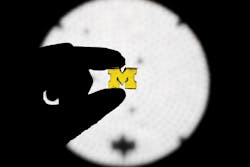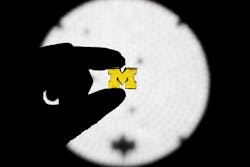ANN ARBOR, MI – A team of researchers at the University of Michigan (U-M) has demonstrated a new approach to 3D printing (also known as additive manufacturing) that lifts complex shapes from a vat of liquid up to 100X faster than conventional 3D printing processes.
The method solidifies the liquid resin using two lights to control where the resin hardens, and where it stays fluid. This enables the research team to solidify the resin in more sophisticated patterns. They can make a 3D bas-relief in a single shot rather than in a series of 1D lines or 2D cross-sections. Their printing demonstrations include a lattice, a toy boat, and a block M (FIGURE).
A new way to 3D print uses two lights to control the solidification of resin, enabling complex shapes to be pulled from a vat at 100X the print speed of conventional 3D printers. (Image credit: Evan Dougherty)
By creating a relatively large region where no solidification occurs, thicker resins—potentially with strengthening powder additives—can be used to produce more durable objects. The method also bests the structural integrity of filament 3D printing, as those objects have weak points at the interfaces between layers.
An earlier solution to the solidification-on-window problem was a window that lets oxygen through. The oxygen penetrates into the resin and halts the solidification near the window, leaving a film of fluid that will allow the newly printed surface to be pulled away. But because this gap is only about as thick as a piece of transparent tape, the resin must be very runny to flow fast enough into the tiny gap between the newly solidified object and the window as the part is pulled up. This has limited vat printing to small, customized products that will be treated relatively gently, such as dental devices and shoe insoles.
By replacing the oxygen with a second light to halt solidification, the research team can produce a much larger gap between the object and the window—millimeters thick—allowing resin to flow in thousands of times faster.
The key to success is the chemistry of the resin. In conventional systems, there is only one reaction. A photoactivator hardens the resin wherever light shines. In the U-M system, there is also a photoinhibitor, which responds to a different wavelength of light. Rather than merely controlling solidification in a 2D plane, as current vat-printing techniques do, the U-M team can pattern the two kinds of light to harden the resin at essentially any 3D place near the illumination window.
U-M has filed three patent applications to protect the multiple inventive aspects of the approach, and Timothy Scott, U-M associate professor of chemical engineering who co-led the development of the new 3D printing approach with Mark Burns, the T.C. Chang Professor of Engineering at U-M, is preparing to launch a startup company.
Full details of the work appear in the journal Science Advances.

